Reunião de imagens e informações antigas e modernas sobre lirone/lira da gamba, para comparação, estudo e visão de conjunto.
By 1luthier

Postagem em construção (ainda não obedece a uma ordem cronológica das informações)...
Muitas imagens podem ser abertas em outra janela em tamanho maior.
Lirone (from Wikipedia)
The lirone, the bass member of the lira family of instruments, is a bowed string instrument with between 9 and 16 gut strings. It is held between the legs in the manner of a cello or viol and like the viol its neck is generally fretted. The lirone was primarily used in Italy during the late 16th and early 17th centuries (and particularly in the time of Claudio Monteverdi) to provide continuo, or harmony for the accompaniment of vocal music. Its flattened bridge allows for the playing of chords of between three and five notes. It is essentially a larger version of the lira da braccio, which has a similar wide fingerboard, flat bridge, and leaf-shaped pegbox with frontal pegs.[1]
Despite the resurgence in Baroque instrument performance during the 20th century, only a handful of musicians play the lirone. Notable performers on the instrument include Erin Headley of England, Hille Perl of Germany, Annalisa Pappano of the United States, Laura Vaughan of Australia, and Paulina van Laarhoven of the Netherlands.
References- Erin Headley. "Lirone", Grove Music Online, ed. L. Macy (accessed November 11, 2006), grovemusic.com (subscription access).
- John Weretka. "Homer the lironist: P.F. Mola, Art and Music in the Baroque" [1]
Notes
- ^ Headley

Michael Praetorius [born Michael Schultze] (livro Syntagma Musicum, de 1614-20) :
- desenho de lira da gamba italiana, com medida em pés (da época)
- 3 pontas finas e uma trapezóide
- cavalete parece baixo (pequena altura), como o de Mersenne
- posição dos efes (aberturas no tampo) não condizente com o uso de uma alma (portanto não deve ter alma, o que contribui para um som mais fraco/abafado/"lento")
- desenho dos Cs muito fechado, o que poderia (juntamente com o cavalete baixo) dificultar certas arcadas, embora não pareça ser instrumento para solo
- assemelha-se a um violoncelo
- desenho da paleta/cravelhame interessante para cópia (especialmente para 2 cravelhas no topo)



Marin Mersenne (livro Harmonie Universelle, de 1636 — autor da época; homem de ciência famoso [mais confiável? apresenta alguns desenhos de instrumentos muito bons, e outros muito primários]):
- boa explicação para o uso de cavalete mais baixo
- bom desenho do cavalete

- ilustração de uma lira [qual? mais abaixo aqui, no artigo de Weretka, esse desenho do Mersenne irá reaparecer, já com o nome de lirone (!), junto ao muito semelhante de Athanasius Kircher; pelas cordas poderia ser uma lira da gamba, mas com o cravelhame não em forma de folha/palma e sim de caixa curva com cravelhas laterais]
- o desenho do corpo não é comum aos considerados pelos luthiers atuais [tem o bojo mais largo no centro; compare com o accordo enorme, adiante; há instrumentos de outros antigos luthiers com formato semelhante, mas considerados de "fala lenta", talvez por essa forma complicar o deslocamento de ar internamente e pela falta de alma]
 [o belo basse de viole de 1547, de Pelegrino Zanetto, ilustrado na Encyclopédie Larousse de la Musique, vol. 2, p. 478), tem um formato parecido, mas com ombro duplo e o bojo maior embaixo]
[o belo basse de viole de 1547, de Pelegrino Zanetto, ilustrado na Encyclopédie Larousse de la Musique, vol. 2, p. 478), tem um formato parecido, mas com ombro duplo e o bojo maior embaixo]
Georg Kinsky - catálogo Köln-Leipzig [catálogo de mais de 2000 páginas, uma mina de informações — pena que esteja somente em alemão, o que dificulta a consulta, mas é espetacular]:
- lira da gamba italiana, ca.1659 [meu "pão-de-mel"]


- lira da gamba de Brensio, 1592 [não original: adaptado/transformado/canibalizado de outro instrumento]










- lira da gamba de F. da Salò, ca.1612 [não original: adaptado/transformado/canibalizado de outro instrumento], com as medidas tiradas pelo restaurador recentemente [arquivo em PDF]


- arciviolata lira:

Museu de Bruxelas (catálogo de V.-Ch. Mahilon, 1900 - Museu de Instrumentos do Conservatório Real de Bruxelas):
- lira da gamba ou lirone perfetto, ou arce-viola de lira ou ainda accordo na Itália (instrumento de número 1444, encontra-se no vol. III, p. 61-3), tem 1,10 m de altura total e 43 cm de largura máxima [algo em torno de 40 cm de largura máxima acho que já seria de bom tamanho para resolver a insatisfação com vários dos meus projetos-pilotos que estavam tentando manter a largura de tua viola da gamba — seria 3 cm mais estreita que essa de Bruxelas, mas seria 3 cm mais larga que a tua VG! E aí, topa abrir mais as pernas? A figura que coloquei depois dos trechos reproduzidos do catálogo é um accordo, tirada de uma Wikipedia do Leste europeu, mas veja que tamanho enorme. Outra coisa: engraçado é que parece que ninguém questiona nem a autoria, nem a "beleza" do formato geral e dos efes em particular, nem a idade desse instrumento de Bruxelas! Nem se poderia ser uma "reconstituição" do século XVIII ou XIX, por exemplo. Nada! Estranho.]
Reproduzindo:



Grove's Dictionary:
- (baseado em quem?) informa que a altura das faixas é metade do cello [Verificar direito isso, já que a maioria parece ter pelo menos uns 9 cm de faixa. Meu violão tem 9 cm em cima e 10 cm embaixo, e acho que menor que isso pode comprometer a existência de um mínimo de sonoridade. Mas quem decide é vc.]
Lirone [lira da gamba, lira in gamba, lyra de gamba, gran lira, lira grande, lirone perfetto, lyra perfecta, lira doppia, arciviolata, arciviolatalira, arcivioladaslyras, lyrone, lyra, lira]
(It.).
A larger relative of the Lira da braccio, in use from approximately 1500 to 1700, primarily in Italy. Both types of lira were bowed chordal instruments, their chief use being to accompany the voice, but the lirone was played between the knees rather than under the chin because of its size. It accommodated many more strings – as few as nine and as many as 20 – and was therefore capable of playing in a greater number of keys. Its repertory was more comprehensive than that of the lira da braccio, covering nearly all genres from the frottola to opera and oratorio (whereas the lira da braccio was more specifically associated with the accompaniment of the poetry and song of the Italian humanists).
2. History in Venice, Florence and Rome.
3. Other Italian and European centres.
4. Associations with other instruments.
5. Surviving instruments and iconography.
6. Modern-day revival.
by ERIN HEADLEY

1. Structure, tunings and playing techniques.
The following conclusions can be drawn about the lirone's structural characteristics from iconographical sources and surviving instruments: it had a body size between that of a tenor and a bass viol, shallow ribs (about half the width of the ribs of a viol or cello), a flat back, and a quasi-violin outline, often with pinched or squared-off corners. It had a short neck and fingerboard, it was fretted, and the pegbox was leaf-shaped with frontal pegs. The bridge was nearly flat (fig.1), and the instrument had serpentine soundholes and a rosette. All the surviving examples are listed in §5 below.
The main function of the lirone was to provide sustained chords for the accompaniment of the voice. Its ingenious tuning system (re-entrant throughout; see Re-entrant tuning) meant that from three to six strings, one or two of them usually open, could be bowed together, which lent extra resonance and gave a particularly ethereal sound. Five extant tunings are known, from Cerreto (1601), Praetorius (2/1619) and Mersenne (1636–7). All these systems (ex.1) make it possible to play a series of chords using the same fingering pattern across the entire fingerboard. Major chords are fingered on the second and third frets, minor ones on the first and third. Augmented, diminished, 7th and 9th chords are obtainable, as are common suspensions (4–3, 7–6, etc.). The system most generally used by modern players is a modified version of the Mersenne tuning (ex.2) which makes available a good balance of sharp and flat keys and thus works well for the most common keys. An exceptional feature of the lirone's tuning is that it affords pure 3rds in all keys: with flats on one side of the bridge and sharps on the other, it is possible to obtain, for example, pure 3rds in both E and B major chords. One instrument also shows double frets, so that alternative chord fingerings can be played in tune as well. Some lironi have bourdon strings to the side of the bridge and pegbox; Cerreto, Praetorius and Mersenne included these in their tunings. Bourdons undoubtedly stem from the lira da braccio tradition; although useful for playing music that is harmonically unadventurous, they are less relevant to repertory such as the large-scale mid-17th-century lament with its kaleidoscopic key changes.
Some of the most valuable information about how the instrument was played comes from Agazzari (1607), who stated that ‘the player of the lirone must bow with long, clear, sonorous strokes’. Given the tuning and simple left-hand technique, the player's main responsibility was evidently to provide shapely, sustained harmonies to support the vocal line. Agazzari also recommended the use of a long bow, and experience suggest this should have a flexible stick and black hair. The bow should not be held above the frog (as with later viol technique), but on the frog itself, to make available the maximum length of bow hair and to enable the player to produce deep strokes well into the string; the effect is thus more ‘vocal’ than instrumental. Agazzari also advised emphasizing the 3rds and 6ths of chords: this is an excellent way to ‘centre’ the sound, and also to obtain maximum projection. To assist resonance and produce a clear sound, Cerreto advised that only the upper strings of a given chord be stopped. For moving quickly from one harmony to another, the technique of jeu barré (using the index finger of the left hand as a temporary nut by placing it across a block of strings) is indispensable. Mersenne's examples demonstrate playing in higher positions on the fingerboard; the resulting sound is akin to that of the ‘halo’ effect produced by a choir of violins.
The most common way of notating a lirone part was by means of a figured or unfigured bass. Both Mersenne and Cerreto included tablature examples, but tablature is impractical for such a consistent and simple fingering system on an instrument with so many strings. One seeming disadvantage of the lirone's tuning is that for half the keys, only root-position chords, and for the remaining keys, only second-inversion chords, are available, with consequent problems of octave displacement in the bass line and inner parts. Francesco Rognoni Taeggio (1620), however, dismissed these as minor annoyances and went on to praise the instrument's soul-lifting, harmonious legato. Practitioners of the 16th century were perhaps less concerned than modern-day musicians about imperfections of part-writing, as may be attested by the fact that both Giulio Caccini and Alessandro Striggio (i) were reported to have played the lirone without a supporting bass instrument. Whatever its imperfections, the lirone was a valued member of the continuo fraternity for nearly two centuries. Its distinct and unique sonority destined it for laments, incantations and invocations, and contemporary writers marvelled at its ability to inspire and elevate the spirit. The wonderful effect of sustained chords on a single string instrument may have originated in the Middle Ages, but it flowered in the Renaissance with the lira da braccio, and reached its full development with the lirone in the Baroque. Although the instrument fell out of use in the early 18th century, its haunting, other-worldly tone colour is echoed in the string accompagnato of Passion music.
2. History in Venice, Florence and Rome.
The first written reference to a large lira is in a letter to Francesco Gonzaga in 1505 from the maker and player Atalante Migliorotti, who described a new type of lira that he was constructing: ‘I shall add strings so that there are 12 … in pure and consummate harmony’. Presumably the instrument was first used for playing frottolas, laudi and other compositions with slow-moving harmonies. References to lironi appear in documents of Venetian religious confraternities from the 1530s until 1631, when a number of lirone players died, presumably in the Great Plague of that year. The continuo body listed in 1618 for the Scuola Grande di S Rocco (where the composers Giovanni Picchi and Giovanni Priuli both worked) included two small organs, three larger ones, two lironi, three theorbos and a violone.
In Florence the lirone was used as early as 1560 to accompany singing for the services of the Compagnia dell'Arcangelo Raffaelo, and Caccini himself was known to have played the ‘gran lira’ while singing inside a false tomb at a religious feast in 1584. His early monody Angel' divin' (I-Fn Magl. XIX.66), with its slow-moving harmonic accompaniment, is a good example of likely repertory for the lirone at the end of the 16th century. In secular music, the ‘arciviolatalira’ (a peculiarly Florentine name for the instrument) had an important role in intermedio repertory (Alessandro Striggio's Fuggi, speme mia, dating from 1565, is one of the most beautiful examples), and in the basso continuo ensembles of early Florentine operas, such as Jacopo Peri's Euridice (1600) and Francesca Caccini's La liberazione di Ruggiero (1625). The last known reference to the playing of the instrument in Florence is dated 1669, but presumably the Medici court lirone player Pietro Salvetti (d 1697) continued to play to the end of his life.
Rome was another important centre for the lirone. The preface to Cavalieri's Rappresentatione di Anima, et di Corpo (1600) recommends the use of the lira doppia (which the composer may well have come across during his time at the Florentine court). Stefano Landi included a lira in the list of continuo instruments in the printed score of his sacred opera Il Sant'Alessio (1634). In 1639 André Maugars described the marvel of hearing the lirone in Roman villas and in oratories; he may well have heard any of the six oratorios attributed to Luigi Rossi, or others by Marco Marazzoli, Domenico Mazzocchi or Bernardo Pasquini, all of which include substantial and extremely beautiful laments written to be accompanied by the lirone.
3. Other Italian and European centres.
Striggio, who was born in Mantua, was probably the Lirone’s greatest musical ambassador. He worked mainly for the Medicis in Florence, but his extensive travels took him all around Italy, as well as to London, Flanders, Paris, Innsbruck, Vienna, Landshut, Munich, Augsburg and Brno. He played large and small lire for Maximilian II in Brno, Duke Albrecht V in Munich, and Duke Wilhelm in Landshut (the last of whom, in a letter of 3 August 1574, described Striggio's lirone in some detail). The Graz inventory of 1580 listed a ‘lira in camba’ on which the Bavarian coat of arms was embossed; the Baden-Baden Hofkapelle collection of 1582 included several lyre da gamba; and later, the Austrian emperors Ferdinand III and Leopold I included the lyra in their religious compositions. According to Mersenne, the lyra de gamba was used in France for the accompaniment of psalms; and a grande lire was included in the 1589 inventory of the French luthier Robert Denis (ii). In the south, Cerreto recorded a number of lirone players working in Naples around 1600, while various references to lire are found in 17th-century Sicilian church archives, and Spanish players' names appear in early biographical sources. Finally, the printed inventory (1666) of the Milanese nobleman Manfredo Settala includes one 11-string arciviola (which ‘con arco longa rende melodia soavissima’) and four other lironi.
4. Associations with other instruments.
There are a few examples of lironi playing with trombone consorts, the most notable being Striggio's lament for the 1565 intermedii (in which the instruments are placed off-stage); here the gentle regal-like quality of the lirone binds the ensemble very effectively. The lirone also joins a viol consort in Francesca Caccini's Ruggiero. Although the organ and the lirone might be expected to cancel each other out – and the lirone was often used in place of the organ – the two actually blend surprisingly well, particularly if the organist avoids the middle register: a marvellous layered chordal effect can be achieved with the keyboard player's right hand covering the register above the lirone, the left hand playing the bass and the lirone in the middle of the texture. Numerous references to the lirone playing with plucked instruments, particularly the chitarrone, abound, but Luigi Rossi went further to combine it with the harpsichord in his oratorios (albeit it with a supporting bowed bass). A combination of a bowed bass instrument (bass violin, violone etc.) and lirone is very effective; the bass instrument should probably play at 8' pitch.
5. Surviving instruments and iconography.
There are seven surviving examples, only some of which were originally lironi. The earliest, by L. Morella (1530 or 1550) is now housed in the Conservatório Nacional, Lisbon; a similar instrument, but more crudely designed and executed, is the anonymous example of about 1550 in the Musée des instruments de musique, Brussels. There are three in the Musikinstrumenten-Museum, University of Leipzig: two may originally have been viols (by Antonio Brensio and Gasparo or Francesco da Salò), while the third is in fragments (pegbox, neck, tailpiece and end block). Before World War II this last instrument was part of the Kraus Collection in Florence, and it is depicted (not always accurately) in a number of 17th-century paintings. The lirone by Wendelin Tieffenbrucker (c1590), now in the Kunsthistorisches Museum, Vienna, is perhaps the most elegant and eye-catching with its festooned body shape, but it may have been cut down from a cello. More recently, an anonymous figure-of-eight example has been discovered in a private collection in Burg Sternberg, Germany (see David).
Besides woodcuts, prints and drawings, there are a number of important and reasonably accurate 17th-century paintings of lironi, including Pier Francesco Mola's Homer (Gemäldegalerie Alte Meister, Dresden; fig.2), Ferdinand Bol's Dame mit lira da gamba (Kunsthistorisches Museum, Vienna), an anonymous Apollo with lira da gamba (source unknown, mid-17th century; see Disertori), Jan Roos's Orphée charmant les animaux (private collection, Gênes; and A.D. Gabbiani's Ferdinando de’ and his musicians Medici (Palazzo Pitti, Florence); the last portrays Pietro Salvetti holding his cello and bow, with his lirone propped next to him.
6. Modern-day revival.
Since the early 1980s the lirone has enjoyed a successful revival, beginning with Erin Headley's research, performances and recordings, and has once more been restored to its rightful place in the continuo ensemble. It is no longer a rare event to hear the instrument in Baroque opera, oratorio or vocal chamber music. The lirone has been taken up professionally by other players, most notably Imke David, Paulina van Laarhoven and Hildegard Perl, while distinguished makers include Henner Harders, Peter Hütmannsberger, Günter Mark and John Pringle. In 1997 the Lira-Forum was founded by Igor Pomykalo in Vienna for the exchange of information about lire da braccio, lironi, lyra viols and related instruments.
BIBLIOGRAPHY
MersenneHU
PraetoriusSM, ii
PraetoriusTI
S. di Ganassi dal Fontego: Regola rubertina (Venice, 1542); ed. W. Eggers (Kassel, 1974); Eng. trans., JVdGSA, xviii (1981), 13–66
L. Zacconi: Prattica di musica (Venice, 1592/R)
S. Cerreto: Della prattica musica vocale et strumentale (Naples, 1601/R, 2/1611)
A. Agazzari: Del sonare sopra 'l basso (Siena, 1607, 2/1608); Eng. trans. in Strunk SR1
A. Banchieri: Conclusioni nel suono dell'organo (Bologna, 1609/R, 2/1626 as Armoniche conclusioni nel suono dell'organo; Eng. trans., 1982)
P. Cerone: El melopeo (Naples, 1613/R)
F. Rognoni Taeggio: Selva di varii passaggi (Milan, 1620/R)
A. Maugars: Response faite à un curieux sur le sentiment de la musique d'Italie, escrite à Rome le premier octobre 1639 (Paris, c1640, copies in F-Pn and Pm); ed. J. Heuillon (Paris, 1991, 2/1992); ed. H.W. Hitchcock with Eng. trans. (Geneva, 1993)
A. Kircher: Musurgia universalis (Rome, 1650/R)
B. Disertori: ‘L'arciviolatalira in un quadro del seicento’, RMI, xliv (1940), 199–211
D. Arnold: ‘Music at the Scuola di San Rocco’, ML, xl (1959), 229–41
D. Arnold: ‘Music at a Venetian Confraternity in the Renaissance’, AcM, xxxvii (1965), 62–72
H.M. Brown: ‘Psyche's Lament: some Music for the Medici Wedding in 1565’, Words and Music: the Scholar's View … in Honor of Tillman Merritt, ed. L. Berman (Cambridge, MA, 1972), 1–28
H.M. Brown: Sixteenth-Century Instrumentation: the Music for the Florentine Intermedii, MSD, xxx (1973)
C.A. Miller: The Writings of Jerome Cardan on Music, MSD, xxxii (1973)
H.E. Smither: A History of the Oratorio, i (Chapel Hill, 1977)
J.W. Hill: ‘Oratory Music in Florence, I: Recitar cantando, 1583–1655’, AcM, li (1979), 108–36
J.W. Hill: ‘Oratory Music in Florence, II: at San Firenze in the Seventeenth and Eighteenth Centuries’, AcM, li (1979), 246–67
W.F. Prizer: ‘Isabella d'Este and Lorenzo da Pavia, “Master Instrument-Maker”’, EMH, ii (1982), 87–127
C.A. Elias: ‘Musical Performance in 16th-Century Italian Literature: Straparola's Le piacevoli notti’, EMc, xvii (1989), 161–73
D. Butchart: ‘The Letters of Alessandro Striggio: an Edition with Translation and Commentary’, RMARC, xxiii (1990), 1–78
I. David: Della lira da gamba (thesis, Schola Cantorum Basiliensis, 1995)
Ashmolean Museum (Museu de Oxford; coleção Hill, etc.):
- baixo de viola de Gasparo da Salò e outro [nome?] instrumento dele [realmente?] semelhante no corpo [mas com visíveis diferenças importantes, na posição e formato das aberturas, que indica uso de alma em um deles]


- notável é o desenho dos "bicos"/pontas dos Cs desses originais [serão mesmo?], em que as "dobras/pregas" no tampo são muito sutis [ao contrário daquelas cópias [?] de Brensio, de F. da Salò, de Henner Harders e Bert Dekker (a prega mais "acintosa"); essas "pregas", avançando pelo tampo além dos tacos internos dos Cs, além de poderem aumentar o peso, podem interferir na sonoridade do instrumento, abafando-a]
Victor Penniman (manual moderno):
- usa a informação do Mersenne para altura do cavalete [e suas consequências: pouca inclinação do braço, etc.]
- modelo simplificado, austero, podemos mesmo dizer feio [formato antigo, de fiddle/vielle/vihuela/chitarra/violão; parece instrumento feito "para não mostrar", apenas para uso em estúdio e/ou estudo]
- é lira da gamba e não lirone? [isso dá pano pra manga... rs]








[Estranho: no desenho com o cravelhame e a correspondência das 12 cordas, há uma corda a mais do que as 11 do instrumento real que ilustra esse método do Penniman.]
Marco Ternovec, luthier (site liuteria-antica.com):
País: Bélgica.
- considera a existência de dois instrumentos distintos, mas trata-os como semelhantes com tamanhos diferentes
- usa, no entanto, o mesmo tamanho de estandarte para ambos [preguiça, ou o quê?; um bom luthier não deveria fazer isso]
- baseia seus modelos em ilustração do livro de Praetorius [o que tem seus prós e contras; além disso, a colocação dos efes sugere, assim, o não-uso de alma, e sonoridade "lenta" e pouco ampla, por consequência (embora isso seja subjetivo: um cellista e um violista da gamba partem de referenciais diferentes)]
Reproduzindo Ternovec:

 As the name already clearly says is lirone (Lirone perfetto mentioned by Praetorius or Arciviolatalira from Lodovico Zacconi, Prattica di Musica - 1592) a larger version of the lira da gamba. Because of lower tuning is much more useful instrument for continuo playing without being supported by another bass instrument.
As the name already clearly says is lirone (Lirone perfetto mentioned by Praetorius or Arciviolatalira from Lodovico Zacconi, Prattica di Musica - 1592) a larger version of the lira da gamba. Because of lower tuning is much more useful instrument for continuo playing without being supported by another bass instrument.



Henner Harders, luthier (site violworks.com):
Location: Germany.
- cópia de Brensio [na verdade, do instrumento modificado no séc. 19)
- usa alma!
- pouca inclinação do braço ---> cavalete baixo







 Reproduzindo:
Reproduzindo:Lira da gamba / Lirone
based on Antonius Brensius 1592
The lira da gamba is a continuo instrument, which was especially used for accompanying voices at the time of Monteverdi. It has a very flat bridge for bowing 3-5 strings at once.
My Lirone is based on an instrument by Antonius Brensius, Bologna 1592, which is in the Musikinstrumentenmuseum in Leipzig. This instrument I find ideal as a starting point for a Lirone because of its wide, but short, body. I arrived at a string length of ca. 54 cm by examining the remains of another Lirone, which is in the same museum. I make the instrument with between 13–16 strings, according to personal preference.
Body length 62.8 cm, string length ca. 54cm.
' Henner's is the fourth lirone that I have owned over the past 20 years and it is definitely the most beautiful and flexible one that I have ever played; it easily responds to all variations of pressure and bowspeed, making the mesa di voce, the esclamazione, the pian piano and all other nuances effortless and three-dimensional. Especially unique to this instrument is its 'throaty' quality, as if it has a real voice, something that is essential for an instrument whose main role is to accompany singers.' (Erin Headley)
more photos:
Bert Dekker, luthier (site http://www.bertdekker.com/index.html):
Location: Vries, The Netherlands.
- copia Brensio [a "dobra/prega" do tampo é a mais "acintosa" entre todos os luthiers modernos que copiam esse modelo]
Reproduzindo:
Lirone after Antonio Brensius     | |||||||||||||||||||||||||||
| -IN GENERAL- stringlength: 580mm. This instrument has a large carrying sound. Still the typical delicate timbre of the lirone is preserved. Easy to play and very open. The linings and roset are like the original. The pegbox (19th century) is replaced by a model seen on a lira da braccio of 1580, which I found more suitable. the prices are from: € 9500,00 (incl. 19% VAT, for EU citizens) € 7980,00 (excl. 19% VAT, for non EU citizens) See also Terms and Conditions. -THE ORIGINAL- the original instrument is part of the collection of "Musikinstrumenten Museum der Universität Leipzig in Germany. They gave me the upportunity to measure and study it. Dated 1592 -ABOUT ANTONIO BRENSIUS- Not much is known about him, except that he has worked in Bologna. He signed the instrument with: Antonio Brensius Bonon. (Bonon means: from Bologna) -ABOUT THE PICTURES- The thumbnails on this page which can be enlarged by clicking on them, show you a variety of the Brensius models I have made over the years. The name of each set of thumbnails is the family-name of the first owner of that particular viol. |
| ||||||||||||||||||||||||||
Lira da gamba de Laura Vaughan
(feito pelo luthier Ian Watchorn, de Melbourne):
- modelo baseado em lira da braccio: bundinha em baixo e pontas finas (mais salientes em cima) [opção pelo formato por não considerar serem muito funcionais os instrumentos "históricos" e pela canibalização sofrida por alguns deles, não sendo possível confirmar a sua originalidade — concordo em gênero, número, etc.; e acho que, para uma mulher tocar, ficou mais adequado do que aquela "mulata-DiCavalcântica" do Salò/Brensio/etc.)
- decorações inspiradas em ornamentações de época (o desenho de uma viola no livro do Mersenne apresenta desenhos semelhantes)


Marco Salerno, luthier (site http://www.marcosalerno.it/lirone.html)
via Colle Carnarolo, 24
00039 ZAGAROLO (Roma)
Italy
LIRONE | |
 |

Owen Morse-Brown, luthier (site http://www.owenmorse-brown.com/index.htm)
2 Little Snarlton Farm, Snarlton Lane,
Melksham, Wiltshire
England SN12 7QP
- baseado em instrumentos de G. da Salò [ele não diz exatamente que é o instrumento do Museu de Leipzig, atribuído ao filho de Gasparo, Francesco, como (sem citar nomes) acusa Ternovec; Gasparo fez vários "basse de viole" com formato semelhante]
Reproduzindo:
| lirone (lira da gamba) |
| home |
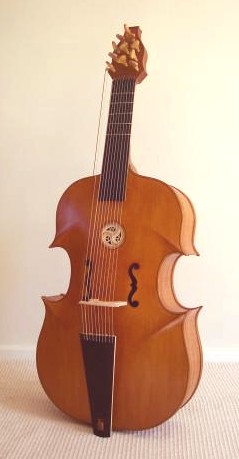 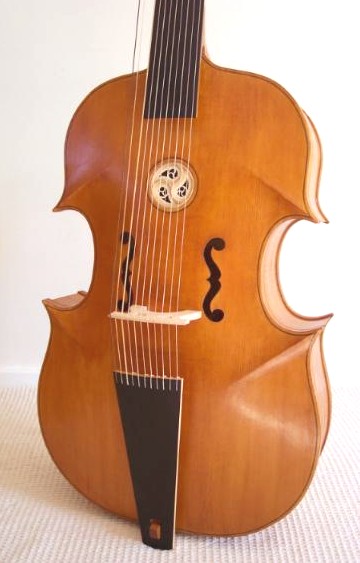 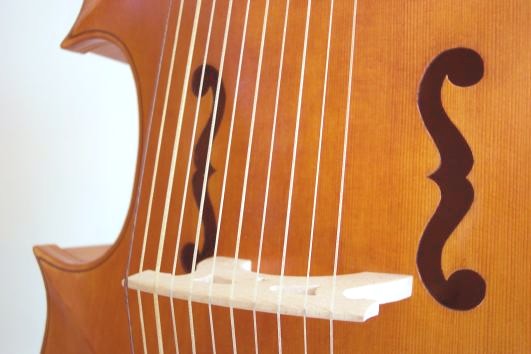 |
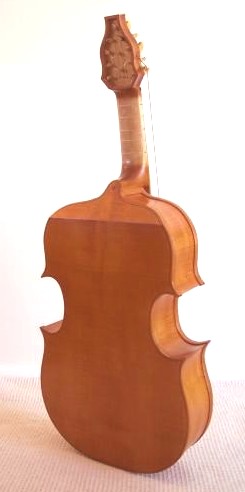 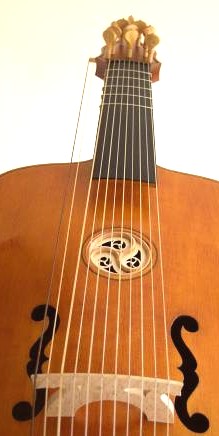 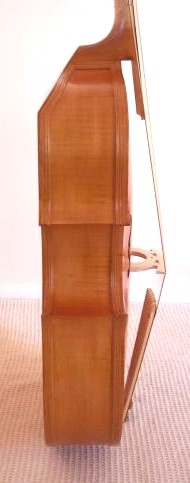 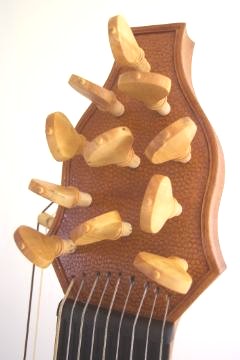 |
| This is an 11 string lirone based on instruments by Gasparo da Salo of Brescia. Among instruments by him that survive is one in Leipzig that is presumed to have been a lirone, although its neck is not original. There is also a viol in the Ashmolean Museum in Oxford with an almost identical body. It is this instrument that is the basis for the body of my lirone, with the neck to my own design and the head based on that of a lira da bracio by Givanni Maria of Bresica from 1575 (also in the Ashmolean Museum). The tuning of the instrument pictured is taken from 'Della prattica musicale vocale et instrumentale' (1601) by Cerretto which is as follows: G-g (off the fingerboard) c-c´-g-d´-a-e´-b-f#´-c#´. It has a string length of 55cm and is also available with your specified number of strings and tuning. There is as always the possibilty of extra decoration, carving or purfling |
Günther Mark, luthier (site http://www.gkmark.de/)



Lirone de Annalisa Pappano [luthier?]
- muito interessante conjunto, faz uma média geral (mas com cravelhame não em forma de folha)


Gary [?] - Luthier Workshop (fotos em: http://picasaweb.google.com/westalfarley/LuthierWorkshop#)
Zagarolo, Italy



Glossario degli strumenti musicali
usati nel XVII e XVIII secolo
(http://smac.provincia.venezia.it/istrum.html
reproduzido também em:
http://ecolaliste.blogspot.com/2006/02/lista-degli-strumenti-musicali-usati.html)
- define lira da gamba, lirone e viola lira, dizendo que o nome lirone era empregado quando usado em procissões [há em outras fontes (Luis Henrique. Instrumentos musicais. Lisboa: Fund. Gulbenkian) referências a "violoncelos de procissão"]
LIRA DA GAMBA
strumento ad arco, con fino a quattordici corde normali e due di bordone. Si suonava tenendola fra le ginocchia.
LIRONE
altro nome della lira da gamba, specie quando era usata nelle processioni.
VIOLA LIRA
piccola viola da gamba bassa. Aveva varie accordature, e la sua parte era scritta in intavolatura.
Hyacinth Abele (Die Geigen, ihre Geschichte und ihr Bogen, p. 2):
- cita o lirone no séc. 16, na Itália, e dá tb. o nome de Viola di Bordune.
Artigo Homer, the lironist
Weretka, J. (2007). Homer the lironist: P. F. Mola, art and music in the baroque. Chelys Australis, (6), 1-12.
| Abstract | Pier Francesco Mola’s Homer dictating (1663 – 66) shows the Classical poet dictating poetry to the accompaniment of his own playing of the lirone. This paper explores the intersections between fantasy and reality in this painting, and examines the ways in which Mola’s image captures the ‘true’ history of the lirone and its position in society, as well as the ways in which wilfully inaccurate archaeology was used as a site for a polemic on the hierarchical superiority of stringed instruments in the late Renaissance and Baroque. Probing musical treatises, the extant repertoire, and documentary evidence from contemporary novelle, diaries and festival records, this paper seeks to understand why Mola placed the lirone, invented at the turn of the sixteenth century, into the hand of a poet dead for almost two and a half millenia. |
| Type | Journal (Paginated) |
| Notes | Deposited with permission of Chelys Australis: Journal of the Australian Viola de Gamba Society. Figure 1 reproduced with permission of the Erich Lessing Culture and Fine Arts Archives. |


 Ilustração de lirone do livro de Athanasius Kircher, Musurgia universalis (Roma, 1650). Esse e o de Mersenne, acima, que no livro ele chama apenas de Lira, têm o mesmo desenho daquele accordo enorme tirado de uma Wikipedia, reproduzido junto ao lirone de Bruxelas, acima.
Ilustração de lirone do livro de Athanasius Kircher, Musurgia universalis (Roma, 1650). Esse e o de Mersenne, acima, que no livro ele chama apenas de Lira, têm o mesmo desenho daquele accordo enorme tirado de uma Wikipedia, reproduzido junto ao lirone de Bruxelas, acima.
http://dtl.unimelb.edu.au/R/HLD7GTEGTAFQMELXPLGB8KVS6P4IG11EM34D7SKLAAF2RTYT2S-00031?func=dbin-jump-full&object_id=67292&pds_handle=GUEST
===============================
Ander Arroitajauregi Aranburu
anderviols at gmail
(site http://web.jet.es/arroitaja/egosten.html)
Reproduzindo (http://web.jet.es/arroitaja/egosten7.html):
Thirteen string lirone or lira da gamba.
What do we know about this instrument? Not much, me at least. I will try to gather as much information as possible to see if we can learn something about it.

[esse instrumento é o "lirone de Brussels" — ver catálogo de Mahilon, acima — e não tem nada a ver com o "lirone" do luthier mostrado a seguir; o espaçamento entre as cordas parece pequeno, e assim também o cavalete; é um instrumento meio tosco, desproporcionado, efes muito pequenos, e com menos cordas do que o realizado pelo luthier]
There are a few instruments surviving in museums and it seems that none of them was originally a lirone (except perhaps the XIX century instruments that were built as lironi)
The lack of original instruments made us to base our work on a painting.

This is a thirteen string lirone, yet to be finished.
We used the painting as a guide to get the size and general proportions of the instrument.
The painting is Ferdinand Bol's Dame mit lira da gamba at the kunsthistorisches Museum in Vienna
[bem parecida com aquela freira do início desta postagem, e tb. com o Homer dictating, de Pier Francesco Mola, logo acima]

Reproduzindo mais (http://web.jet.es/arroitaja/egosten9.html):
Thirteen string lirone or lira da gamba 2.

 And here there are some pictures of the finished instrument.
And here there are some pictures of the finished instrument.As said on the previous post, this instrument is based on a painting by Ferdinand Bol's ''Dame mit lira da gamba'' at the kunsthistorisches Museum in Vienna.
It does not follow the exact outline of the painting, on the actual instrument corners are less pronounced (even though this ''curvy'' shape can be seen on other instrument paintings).
It has thirteen strings (two bourdons) and even though there is no view of the back it is arched.
Strung all in gut.
The bow is pretty long and it held from the nut without touching the hairs to get the maximung playing length.
This is what Adriano Banchieri said in his "Conclusioni nel suono dell'organo" (Bologna, 1611):





Reproduzindo mais ainda (http://vihueladearco.blogspot.com/2009/02/proper-pictures-of-lirone.html):
jueves 12 de febrero de 2009
Proper pictures of the Lirone
Lironearen ganorazko argazkiak, Belen ek ataratakuak. Eskerrikasko!
Algunas fotos del Lirone, sacadas/tomadas por una buena fotógrafa. Gracias Belén.









John Pringle, luthier (site http://www.pringleviols.com/catalogue/lira_da_braccio_and_lirone.htm)
Reproduzindo:
Lirone | ||||
|---|---|---|---|---|
| ||||
| ||||

***
Peter Hütmannsberger, luthier
(site http://www.violine.at/other_instruments.html)
Lirone after Tieffenbrugger


The second half of the 16th century was the time of a very prominent maker of string instruments in Padova, Italy. Wendelin Tieffenbrucker was only one of the members of a well known family of lute makers in and around Venice of the 16th century. Their instruments were regarded as more modern and advanced than the ones from the Füssen area in Germany. Most of his remaining instruments are lutes of various sizes, but the "Kunsthistorisches Museum in Vienna" has an interesting lira da gamba or lirone in its collection.
Having had the chance to examine and measure the instrument in the Vienna collection, I decided to make a copy of the lirone. The head on the Viennese instrument is very simple and not as ornate as the rest of the instrument, which is why I chose to use the head of a lirone depicted in a 16th century Italian painting.
Lirone after Francesco dal Salo
Along one of the ancient trade routes between the North and the South of Europe lies a small town called Brescia. Before Cremona, only 20 miles south of Brescia, became the capital of violin making, Brescia was made famous by the Bertolotti dal Salo family. Gasparo, regarded by some as the inventor of the violin, and his son had a thriving business making instruments. One of the surviving instruments of Francesco, the son of Gasparo, can still be seen in the Instrument Collection of the Leipzig Museum in Germany. As the head of the instrument has not survived I chose to use iconographic evidence of a lirone head again.

Outros lironistas:

 Igor Pomykalo
Igor Pomykalo Anthea Cottee
Anthea Cottee Brigitte Gasser
Brigitte Gasser Ensemble L'Aura Soave [?]
Ensemble L'Aura Soave [?]

 Susanne Braumann
Susanne Braumann Lucas Guimarães Peres
Lucas Guimarães Peres Motomi, aluna de Erin Headley
Motomi, aluna de Erin Headley(continua... [?])















